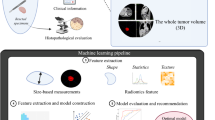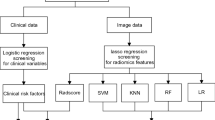Abstract
Objectives
To determine the value of radiomics in predicting lymph node (LN) metastasis in resectable esophageal squamous cell carcinoma (ESCC) patients.
Methods
Data of 230 consecutive patients were retrospectively analyzed (154 in the training set and 76 in the test set). A total of 1576 radiomics features were extracted from arterial-phase CT images of the whole primary tumor. LASSO logistic regression was performed to choose the key features and construct a radiomics signature. A radiomics nomogram incorporating this signature was developed on the basis of multivariable analysis in the training set. Nomogram performance was determined and validated with respect to its discrimination, calibration and reclassification. Clinical usefulness was estimated by decision curve analysis.
Results
The radiomics signature including five features was significantly associated with LN metastasis. The radiomics nomogram, which incorporated the signature and CT-reported LN status (i.e. size criteria), distinguished LN metastasis with an area under curve (AUC) of 0.758 in the training set, and performance was similar in the test set (AUC 0.773). Discrimination of the radiomics nomogram exceeded that of size criteria alone in both the training set (p <0.001) and the test set (p=0.005). Integrated discrimination improvement (IDI) and categorical net reclassification improvement (NRI) showed significant improvement in prognostic value when the radiomics signature was added to size criteria in the test set (IDI 17.3%; p<0.001; categorical NRI 52.3%; p<0.001). Decision curve analysis supported that the radiomics nomogram is superior to size criteria.
Conclusions
The radiomics nomogram provides individualized risk estimation of LN metastasis in ESCC patients and outperforms size criteria.
Key Points
• A radiomics nomogram was built and validated to predict LN metastasis in resectable ESCC.
• The radiomics nomogram outperformed size criteria.
• Radiomics helps to unravel intratumor heterogeneity and can serve as a novel biomarker for determination of LN status in resectable ESCC.






Similar content being viewed by others
Abbreviations
- AJCC:
-
American Joint Committee on Cancer
- AUC:
-
Area under curve
- CT:
-
Computed tomography
- ESCC:
-
Esophageal squamous cell carcinoma
- GLCM:
-
Gray level co-occurrence matrix
- GLRLM:
-
Gray level run length matrix
- GLSZM:
-
Gray level size zone matrix
- ICC:
-
Intra-class correlation coefficient
- IDI:
-
Integrated discrimination improvement
- LASSO:
-
Least absolute shrinkage and selection operator
- LN:
-
Lymph node
- NLR:
-
Neutrophil-to-lymphocyte ratio
- NRI:
-
Net reclassification improvement
- PLR:
-
Platelet-to-lymphocyte ratio
- ROC:
-
Receiver operator characteristic
- VOI:
-
Volume of interest
References
Global Burden of Disease Cancer C, Fitzmaurice C, Allen C et al (2017) Global, regional, and national cancer incidence, mortality, years of life lost, years lived with disability, and disability-adjusted life-years for 32 cancer groups, 1990 to 2015: a systematic analysis for the global burden of disease study. JAMA Oncol 3:524–548
Torre LA, Bray F, Siegel RL, Ferlay J, Lortet-Tieulent J, Jemal A (2015) Global cancer statistics, 2012. CA Cancer J Clin 65:87–108
Wei WQ, Chen ZF, He YT et al (2015) Long-term follow-up of a community assignment, one-time endoscopic screening study of esophageal cancer in China. J Clin Oncol 33:1951–1957
Malhotra GK, Yanala U, Ravipati A, Follet M, Vijayakumar M, Are C (2017) Global trends in esophageal cancer. J Surg Oncol 115:564–579
Zhang HL, Chen LQ, Liu RL et al (2010) The number of lymph node metastases influences survival and International Union Against Cancer tumor-node-metastasis classification for esophageal squamous cell carcinoma. Dis Esophagus 23:53–58
Kayani B, Zacharakis E, Ahmed K, Hanna GB (2011) Lymph node metastases and prognosis in oesophageal carcinoma--a systematic review. Eur J Surg Oncol 37:747–753
Hong SJ, Kim TJ, Nam KB et al (2014) New TNM staging system for esophageal cancer: what chest radiologists need to know. Radiographics 34:1722–1740
van Rossum PS, Xu C, Fried DV, Goense L, Court LE, Lin SH (2016) The emerging field of radiomics in esophageal cancer: current evidence and future potential. Transl Cancer Res 5:410–423
Betancourt Cuellar SL, Sabloff B, Carter BW et al (2017) Early clinical esophageal adenocarcinoma (cT1): utility of CT in regional nodal metastasis detection and can the clinical accuracy be improved? Eur J Radiol 88:56–60
Foley KG, Christian A, Fielding P, Lewis WG, Roberts SA (2017) Accuracy of contemporary oesophageal cancer lymph node staging with radiological-pathological correlation. Clin Radiol 72:693.e691–693.e697
Sala E, Mema E, Himoto Y et al (2017) Unravelling tumor heterogeneity using next-generation imaging: radiomics, radiogenomics, and habitat imaging. Clin Radiol 72:3–10
Yip CS, Davnall F, Kozarski R et al (2013) CT tumoral heterogeneity as a prognostic marker in primary esophageal cancer following neoadjuvant chemotherapy. Pract Radiat Oncol 3:S3
Davnall F, Yip CS, Ljungqvist G et al (2012) Assessment of tumor heterogeneity: an emerging imaging tool for clinical practice? Insights Imaging 3:573–589
O'Connor JP, Rose CJ, Waterton JC, Carano RA, Parker GJ, Jackson A (2015) Imaging intratumor heterogeneity: role in therapy response, resistance, and clinical outcome. Clin Cancer Res 21:249–257
Gillies RJ, Kinahan PE, Hricak H (2016) Radiomics: images are more than pictures, they are data. Radiology 278:563–577
Huang YQ, Liang CH, He L et al (2016) Development and validation of a radiomics nomogram for preoperative prediction of lymph node metastasis in colorectal cancer. J Clin Oncol 34:2157–2164
Wu S, Zheng J, Li Y et al (2017) A radiomics nomogram for the preoperative prediction of lymph node metastasis in bladder cancer. Clin Cancer Res 23:6904–6911
Rice TW, Gress DM, Patil DT, Hofstetter WL, Kelsen DP, Blackstone EH (2017) Cancer of the esophagus and esophagogastric junction-Major changes in the American Joint Committee on Cancer eighth edition cancer staging manual. CA Cancer J Clin 67:304–317
Rice TW, Patil DT, Blackstone EH (2017) 8th edition AJCC/UICC staging of cancers of the esophagus and esophagogastric junction: application to clinical practice. Ann Cardiothorac Surg 6:119–130
Umeoka S, Koyama T, Togashi K et al (2006) Esophageal cancer: evaluation with triple-phase dynamic CT--initial experience. Radiology 239:777–783
van Griethuysen JJM, Fedorov A, Parmar C et al (2017) Computational radiomics system to decode the radiographic phenotype. Cancer Res 77:e104–e107
Medical Research Council Oesophageal Cancer Working G (2002) Surgical resection with or without preoperative chemotherapy in oesophageal cancer: a randomised controlled trial. Lancet 359:1727–1733
Yodying H, Matsuda A, Miyashita M et al (2016) Prognostic significance of neutrophil-to-lymphocyte ratio and platelet-to-lymphocyte ratio in oncologic outcomes of esophageal cancer: a systematic review and meta-analysis. Ann Surg Oncol 23:646–654
Luo LN, He LJ, Gao XY et al (2016) Endoscopic ultrasound for preoperative esophageal squamous cell carcinoma: a meta-analysis. PLoS One 11:e0158373
Lambin P, Leijenaar RTH, Deist TM et al (2017) Radiomics: the bridge between medical imaging and personalized medicine. Nat Rev Clin Oncol 14:749–762
Dai W, Ko JMY, Choi SSA et al (2017) Whole-exome sequencing reveals critical genes underlying metastasis in oesophageal squamous cell carcinoma. J Pathol 242:500–510
Burrell RA, McGranahan N, Bartek J, Swanton C (2013) The causes and consequences of genetic heterogeneity in cancer evolution. Nature 501:338–345
Ng F, Ganeshan B, Kozarski R, Miles KA, Goh V (2013) Assessment of primary colorectal cancer heterogeneity by using whole-tumor texture analysis: contrast-enhanced CT texture as a biomarker of 5-year survival. Radiology 266:177–184
Foley KG, Hills RK, Berthon B et al (2018) Development and validation of a prognostic model incorporating texture analysis derived from standardised segmentation of PET in patients with oesophageal cancer. Eur Radiol 28:428–436
Nakajo M, Jinguji M, Nakabeppu Y et al (2017) Texture analysis of (18)F-FDG PET/CT to predict tumor response and prognosis of patients with esophageal cancer treated by chemoradiotherapy. Eur J Nucl Med Mol Imaging 44:206–214
Coroller TP, Agrawal V, Huynh E et al (2017) Radiomic-based pathological response prediction from primary tumors and lymph nodes in NSCLC. J Thorac Oncol 12:467–476
Aerts HJ, Velazquez ER, Leijenaar RT et al (2014) Decoding tumor phenotype by noninvasive imaging using a quantitative radiomics approach. Nat Commun 5:4006
Panth KM, Leijenaar RT, Carvalho S et al (2015) Is there a causal relationship between genetic changes and radiomics-based image features? An in vivo preclinical experiment with doxycycline inducible GADD34 tumor cells. Radiother Oncol 116:462–466
Rios Velazquez E, Parmar C, Liu Y et al (2017) Somatic mutations drive distinct imaging phenotypes in lung cancer. Cancer Res 77:3922–3930
Funding
This study has received funding by the National Key Research and Development Plan of China (grant number: 2017YFC1309100), National Natural Scientific Foundation of China (grant number: 81771912 and U1301258) and Science and Technology Planning Project of Guangdong Province (grant number: 2017B020227012)
Author information
Authors and Affiliations
Corresponding authors
Ethics declarations
Guarantor
The scientific guarantor of this publication is Changhong Liang.
Conflict of interest
The authors of this manuscript declare no relationships with any companies whose products or services may be related to the subject matter of the article.
Statistics and biometry
No complex statistical methods were necessary for this paper.
Informed consent
Written informed consent was waived by the Institutional Review Board.
Ethical approval
Institutional Review Board approval was obtained.
Methodology
• retrospective
• diagnostic or prognostic study
• performed at one institution
Electronic supplementary material
ESM 1
(DOCX 43 kb)
Rights and permissions
About this article
Cite this article
Tan, X., Ma, Z., Yan, L. et al. Radiomics nomogram outperforms size criteria in discriminating lymph node metastasis in resectable esophageal squamous cell carcinoma. Eur Radiol 29, 392–400 (2019). https://doi.org/10.1007/s00330-018-5581-1
Received:
Revised:
Accepted:
Published:
Issue Date:
DOI: https://doi.org/10.1007/s00330-018-5581-1




